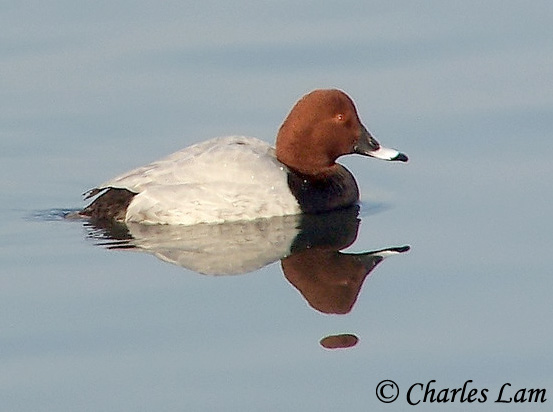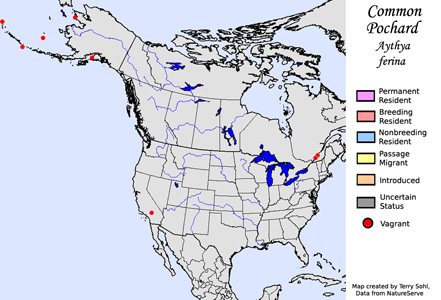| Length: 18-20 inches | Wingspan: 32 inches | Seasonality: Non-resident in South Dakota |
| ID Keys:Males with rusty-heads, black breast and tail, and whitish body. Females drab brownish all over. | ||
 The
Common Pochard is a common diving duck of Eurasia. They are only
extremely rare vagrants in North America, with most sightings happening in
the Aleutians or western Alaska, but sightings have also occurred in
California and Saskatchewan. They are ecological counterparts, and very
similar to, the Redhead duck that is found in
North America.
The
Common Pochard is a common diving duck of Eurasia. They are only
extremely rare vagrants in North America, with most sightings happening in
the Aleutians or western Alaska, but sightings have also occurred in
California and Saskatchewan. They are ecological counterparts, and very
similar to, the Redhead duck that is found in
North America.
Habitat: Found on a variety of water bodies (lakes, reservoirs, and slow moving rivers), but in general requires open water habitat of shallow to moderate depth, with surrounding aquatic vegetation that supports prey items such as snails, mollusks, and aquatic insects. They will occasionally use brackish water areas or sheltered coastal bays, but they strongly prefer inland, fresh water bodies.
Diet: Omnivorous, feeding on both plant and animal matter. Food items may include aquatic plants (seeds, stems, leaves, and roots), algae, aquatic insects and their larvae, small mollusks and crustaceans, and occasionally small fish.
Behavior: Typically a diving duck, diving and swimming under water for food, but they will also upend and feed with just their head under the water. They will also sometimes dabble near the water's surface. Gregarious, sometimes forming very large flocks on their wintering grounds, oftentimes mixing with other species such as Tufted Duck.
Nesting: The nest of a Common Pochard is a shallow depression in thick vegetation, usually within 20-30 feet of a lake or river shoreline. Females incubate the eggs and tend to the young after hatching, but the young must find their own food.
Migration: Most populations are migratory, especially those in the northern half of their range. They breed throughout large swaths of Europe and Asia. Wintering grounds include southern and eastern Asia, western Europe, and northern Africa.
Interactive eBird Map: Click here to access an interactive eBird map of Common Pochard sightings
Similar Species: Redhead, Canvasback
Conservation Status: There are currently no perceived major threats to Common Pochard populations, and the IUCN cites it as a species of "Least Concern".
Further Information: 1) BirdLife International - Common Pochard
2) ARKIVE - Common Pochard
3) RSPB - Common Pochard
Photo Information: Photo taken by Charles Lam - Llicensed under Creative Commons Attribution Share-Alike 2.0 Generic License
| Click below for a higher-resolution map |
 |
| South Dakota Status: Non-resident in South Dakota |
Additional Common Pochard Photos (coming soon!!)
